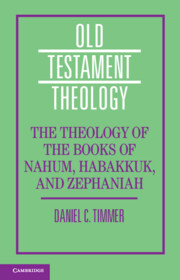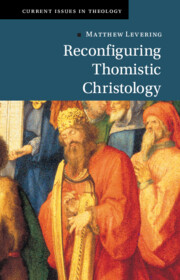51 results
Chapter 1 - Reading Ancient Israelite Prophetic Books
-
- Book:
- The Theology of the Books of Nahum, Habakkuk, and Zephaniah
- Published online:
- 28 March 2024
- Print publication:
- 04 April 2024, pp 1-23
-
- Chapter
- Export citation

The Theology of the Books of Nahum, Habakkuk, and Zephaniah
-
- Published online:
- 28 March 2024
- Print publication:
- 04 April 2024
The theological sources and poetic priorities of Milton's narrative theodicy
-
- Journal:
- Scottish Journal of Theology , First View
- Published online by Cambridge University Press:
- 06 March 2024, pp. 1-17
-
- Article
-
- You have access
- Open access
- HTML
- Export citation
Covenant and Community in Early Rabbinic Literature
-
- Journal:
- Harvard Theological Review / Volume 117 / Issue 2 / April 2024
- Published online by Cambridge University Press:
- 23 February 2024, pp. 228-249
- Print publication:
- April 2024
-
- Article
-
- You have access
- Open access
- HTML
- Export citation
5 - Transnational Fiduciary Law in Bond Markets
- from Part I - The Transnational Formation and Institutionalization of Fiduciary Law
-
-
- Book:
- Transnational Fiduciary Law
- Published online:
- 22 November 2023
- Print publication:
- 08 February 2024, pp 125-145
-
- Chapter
-
- You have access
- Open access
- HTML
- Export citation
8 - Managing Co-ownership
- from Part II - Immovable Property
-
- Book:
- Property Law
- Published online:
- 18 May 2023
- Print publication:
- 01 June 2023, pp 205-229
-
- Chapter
- Export citation

Reconfiguring Thomistic Christology
-
- Published online:
- 24 May 2023
- Print publication:
- 30 March 2023
What Is the Juxtaposition between Silicon Valley and Mount Sinai? Covenantal Principles and the Conceptualization of Platform-User Relations
-
- Journal:
- Journal of Law and Religion / Volume 37 / Issue 3 / September 2022
- Published online by Cambridge University Press:
- 25 October 2022, pp. 446-477
- Print publication:
- September 2022
-
- Article
-
- You have access
- Open access
- HTML
- Export citation
Law at the Backbone: The Christian Legal Ecumenism of Norman Doe
-
- Journal:
- Ecclesiastical Law Journal / Volume 24 / Issue 2 / May 2022
- Published online by Cambridge University Press:
- 29 April 2022, pp. 192-208
- Print publication:
- May 2022
-
- Article
-
- You have access
- Open access
- HTML
- Export citation
1 - What Makes Jews Jewish?
- from Part I - Judaism
-
- Book:
- Judaism, Antisemitism, and Holocaust
- Published online:
- 24 March 2022
- Print publication:
- 31 March 2022, pp 11-33
-
- Chapter
- Export citation
2 - The Stranger, My Brother
- from Part I - Judaism
-
- Book:
- Judaism, Antisemitism, and Holocaust
- Published online:
- 24 March 2022
- Print publication:
- 31 March 2022, pp 34-54
-
- Chapter
- Export citation
Introduction
-
- Book:
- Judaism, Antisemitism, and Holocaust
- Published online:
- 24 March 2022
- Print publication:
- 31 March 2022, pp 1-8
-
- Chapter
- Export citation
Foedus and testamentum: Calvin's federal terminology in Hebrew 8–10
-
- Journal:
- Scottish Journal of Theology / Volume 75 / Issue 1 / February 2022
- Published online by Cambridge University Press:
- 25 March 2022, pp. 1-11
- Print publication:
- February 2022
-
- Article
-
- You have access
- Open access
- HTML
- Export citation
Chapter 5 - The End of Episcopalian Reformation
-
- Book:
- England's Second Reformation
- Published online:
- 05 October 2021
- Print publication:
- 14 October 2021, pp 144-180
-
- Chapter
- Export citation
PRACTICING THE POLITICAL AFTER CHRISTENDOM - Politics after Christendom: Political Theology in a Fractured World. By David VanDrunen. Grand Rapids: Zondervan Academic, 2020. Pp. 400. $29.99 (paper); $19.99 (digital). ISBN: 9780310108849.
-
- Journal:
- Journal of Law and Religion / Volume 36 / Issue 2 / August 2021
- Published online by Cambridge University Press:
- 16 August 2021, pp. 378-382
- Print publication:
- August 2021
-
- Article
- Export citation
A RESPONSE TO THE SYMPOSIUM ON POLITICS AFTER CHRISTENDOM - Politics after Christendom: Political Theology in a Fractured World. By David VanDrunen. Grand Rapids: Zondervan Academic, 2020. Pp. 400. $29.99 (paper); $19.99 (digital). ISBN: 9780310108849.
-
- Journal:
- Journal of Law and Religion / Volume 36 / Issue 2 / August 2021
- Published online by Cambridge University Press:
- 05 August 2021, pp. 424-428
- Print publication:
- August 2021
-
- Article
- Export citation
6 - A Political Theology of the Mosaic Distinction
-
- Book:
- Monotheism, Intolerance, and the Path to Pluralistic Politics
- Published online:
- 04 June 2021
- Print publication:
- 17 June 2021, pp 151-190
-
- Chapter
- Export citation
3 - Judah’s Bible and the Narrative Construction of Biblical Israel
- from Part II - Restoration Eschatology and the Construction of Biblical Israel
-
- Book:
- The Idea of Israel in Second Temple Judaism
- Published online:
- 29 April 2021
- Print publication:
- 20 May 2021, pp 87-120
-
- Chapter
- Export citation
7 - Administrative Kingship and Covenantal Bonds
-
- Book:
- The Intellectual Property of Nations
- Published online:
- 04 June 2021
- Print publication:
- 20 May 2021, pp 207-240
-
- Chapter
- Export citation
7 - Israel, Jews, and Restoration Eschatology in Josephus
- from Part III - Israel and Restoration Eschatology in the Diaspora
-
- Book:
- The Idea of Israel in Second Temple Judaism
- Published online:
- 29 April 2021
- Print publication:
- 20 May 2021, pp 210-232
-
- Chapter
- Export citation



